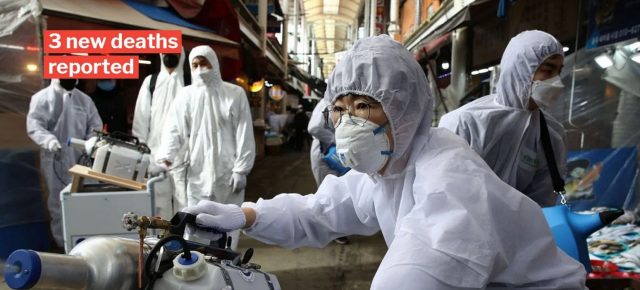The coronavirus COVID-19 is affecting 210 countries and territories around the world and 2 international conveyances.
The 2019–20 coronavirus pandemic is an ongoing pandemic of coronavirus disease 2019 (COVID-19) caused by severe acute respiratory syndrome coronavirus 2 (SARS-CoV-2).
The outbreak was identified in Wuhan, China, in December 2019, declared to be a Public Health Emergency of International Concern on 30 January 2020, and recognized as a pandemic by the World Health Organization on 11 March 2020. As of 16 April 2020, more than 2.1 million cases of COVID-19 have been reported in 210 countries and territories, resulting in more than 140,000 deaths. More than 532,000 people have recovered, although there may be a possibility of relapse or reinfection. The deaths per diagnosed cases varies significantly between countries.
The virus is primarily spread between people during close contact, often via small droplets produced by coughing, sneezing, or talking. While these droplets are produced when breathing out, they usually fall to the ground or onto surfaces rather than being infectious over long distances.
People may also become infected by touching a contaminated surface and then touching their eyes, nose or mouth.The virus can survive on surfaces, up to 72 hours on some. It is most contagious during the first three days after the onset of symptoms, although spread may be possible before symptoms appear and in later stages of the disease.
Common symptoms include fever, cough and shortness of breath. Complications may include pneumonia and acute respiratory distress syndrome. The time from exposure to onset of symptoms is typically around five days, but may range from two to fourteen days. There is no known vaccine or specific antiviral treatment. Primary treatment is symptomatic and supportive therapy.
Recommended preventive measures include hand washing, covering one’s mouth when coughing, maintaining distance from other people, and monitoring and self-isolation for people who suspect they are infected.
Summary
Disease: Coronavirus disease 2019 (COVID-19)
Location: Worldwide
First case: November 17, 2019
Origin: Wuhan, Hubei, China
Symptoms: Fever, cough, shortness of breath, loss of taste, loss of smell, pink eyes, aches and pains
Complications: Pneunomia, ARDS, kidney failure
Causes: SARS-CoV-2
Mode of transmission: Human-to-human transmission via respiratory droplets
Prevention: Avoiding close contact with sick individuals; frequently washing hands with soap and water; not touching the eyes, nose, or mouth with unwashed hands; and practicing good respiratory hygiene
To date – 16 April, 2020 at 1800 BST.
International Statistics.
Coronavirus confirmed Cases: 2,144,886
Deaths: 143,280
Recovered:543,273
Preventative measures and Disruptions
Recommended preventive measures include hand washing, covering one’s mouth when coughing, maintaining distance from other people, and monitoring and self-isolation for people who suspect they are infected. Authorities worldwide have responded by implementing travel restrictions, quarantines, curfews and stay-at-home orders, workplace hazard controls, and facility closures.
The pandemic has led to severe global socioeconomic disruption, the postponement or cancellation of sporting, religious, political and cultural events, and widespread shortages of supplies exacerbated by panic buying. The pandemic caused the largest global recession in history, with more than a third of the global population at the time being placed on lockdown. Schools, universities and colleges have closed either on a nationwide or local basis in 197 countries, affecting approximately 99.9 per cent of the world’s student population.
African Americans
African Americans, especially men, are disproportionately contracting and dying of the coronavirus. For many in the black community, that’s no surprise.
It’s the result of long-term inequalities in the health care system that produced underlying health conditions putting them more at risk, as well as socioeconomic barriers that make them more likely to be in service sector jobs that increase their exposure to the disease.
The numbers are stark: African Americans, who comprise 27 percent of South Carolina’s population, make up 41 percent of confirmed cases and 56 percent of deaths, according to data updated Tuesday 14 April, by the South Carolina Department of Health and Environmental Control.










